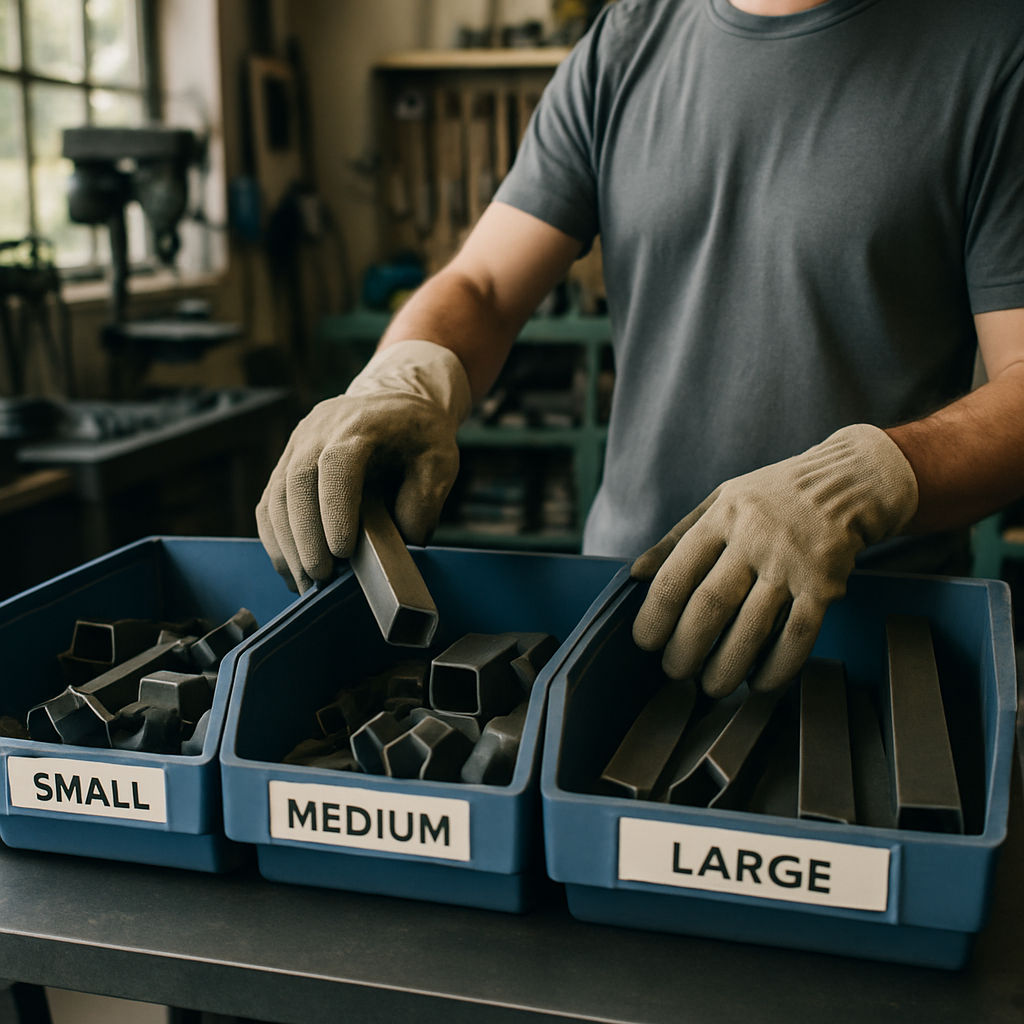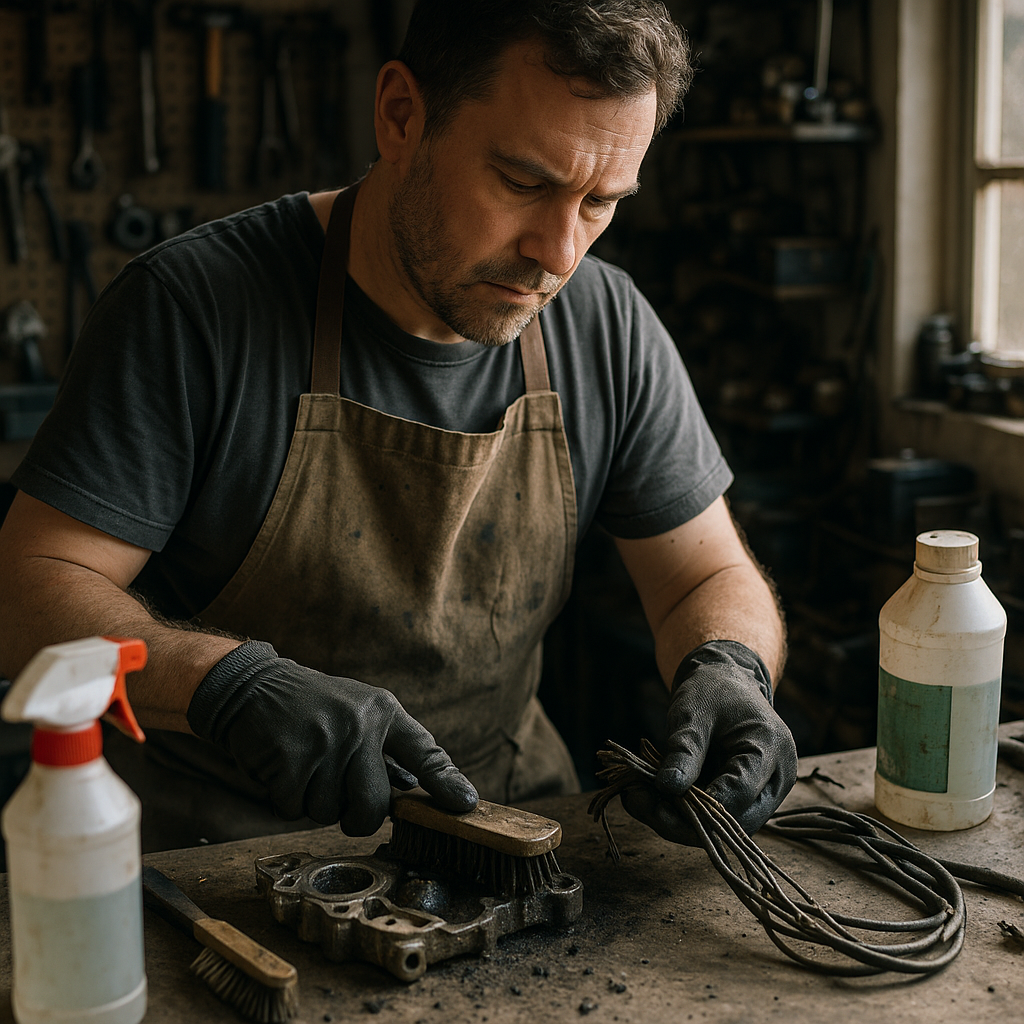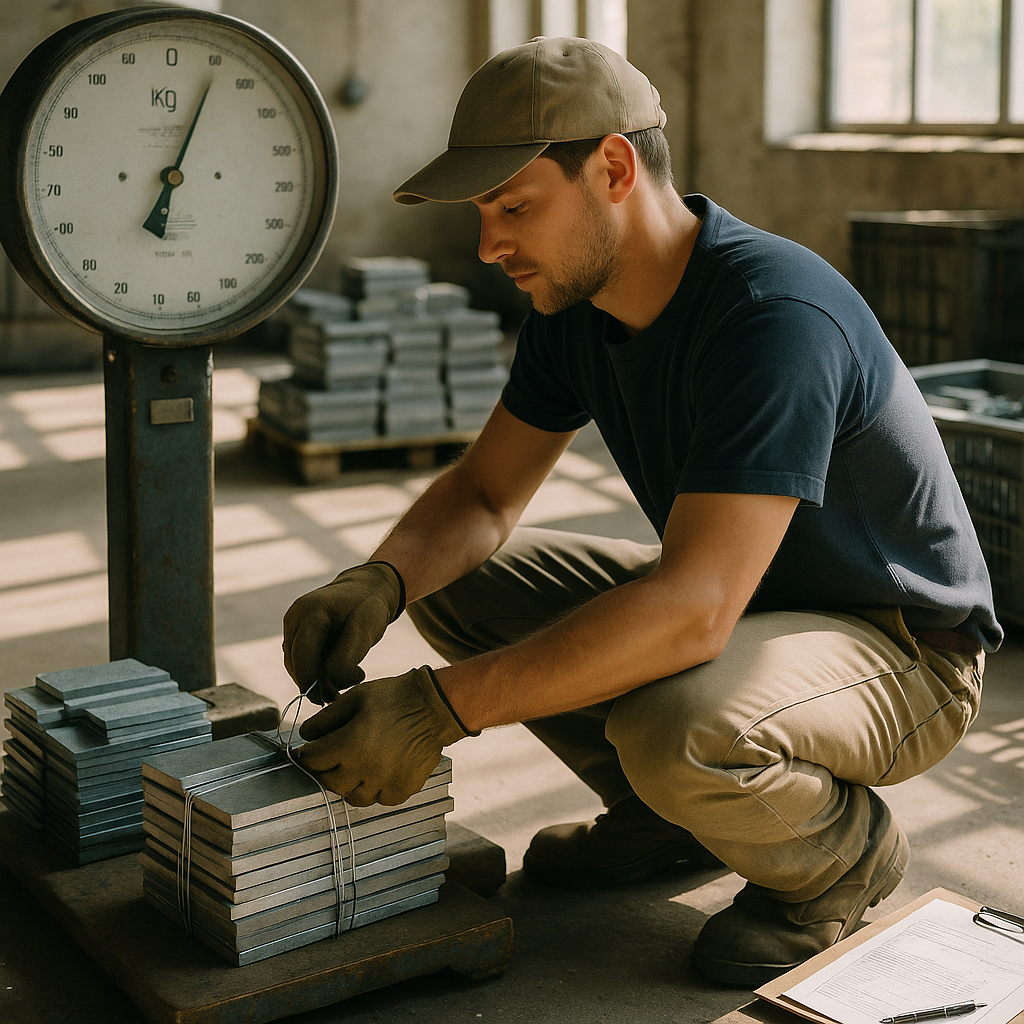5901 Botham Jean Blvd, Dallas, TX 75215
How to Prepare Scrap Metal for Recycling Center
July 20, 2025Did you know recycling one ton of steel saves enough energy to power an average home for over six months? Scrap metal recycling is among our most valuable sustainability practices, conserving natural resources, reducing energy consumption, and keeping valuable materials out of landfills.
Preparing scrap metal for recycling is a structured process that requires proper sorting, cleaning, and handling. Many recycling centers have specific requirements for accepting materials. Without proper preparation, your scrap metal might be rejected or valued at a significantly lower price. Following established guidelines ensures materials move efficiently through the recycling stream, maximizing both environmental benefits and potential financial returns.
Whether you’re a homeowner with a few metal items or a business with industrial quantities, knowing how to prepare your scrap properly makes a difference. This article outlines the key steps to prepare your scrap metal for drop-off at a recycling center. From basic sorting techniques to cleaning methods and transportation tips, you’ll learn how to turn your metal waste into valuable recyclable material.
How Should You Sort Your Scrap Metal?

Properly sorting scrap metal is crucial for maximizing its recycling value. Start by using a magnet test to separate ferrous metals from non-ferrous metals. This fundamental sorting technique can increase returns by 20-40% compared to delivering mixed materials.
The Magnet Test: Your Primary Sorting Tool
A strong magnet is essential for metal sorting. When a magnet sticks to a metal, it indicates ferrous material containing iron. If the magnet doesn’t stick, the metal is non-ferrous, typically commanding higher prices.
For best results, use a neodymium (rare earth) magnet rather than a standard refrigerator magnet. These powerful magnets provide more accurate results and can be purchased online for around $10-15. Simply hold the magnet near each piece of scrap to make your initial separation.
Identifying Common Metals
After the magnet test, identify specific metals by their visual characteristics and physical properties:
Ferrous metals like steel and cast iron are typically heavier, grayish, and may show rust. Non-ferrous metals include copper (reddish-brown), aluminum (lightweight, silvery), brass (yellowish), and bronze (reddish-gold). Each has distinct properties affecting its recycling value.
| Characteristic | Ferrous Metals | Non-Ferrous Metals |
|---|---|---|
| Main Component | Iron | No significant iron content |
| Rust and Corrosion | Prone to rust; exceptions include stainless steel | Resistant to rust and corrosion |
| Magnetic Properties | Typically magnetic | Non-magnetic |
| Weight | Heavier | Generally lighter |
| Recyclability | Can degrade during recycling | Recyclable with minimal degradation |
| Cost | Less expensive | Tends to be more expensive |
Setting Up Your Sorting System
Establish a practical sorting station by following these steps:
- Designate separate, sturdy containers for each metal type
- Clearly label each container (steel, aluminum, copper, brass, etc.)
- Position containers logically based on your workflow
- Keep your magnet accessible for quick testing
For home recyclers, repurposed household items make excellent sorting containers. Plastic storage bins, sturdy cardboard boxes, or clean 5-gallon buckets are ideal options. The key is using containers that won’t tear or break during transport.
Maximizing Value Through Proper Separation
Non-ferrous metals generally fetch higher prices per pound than ferrous metals. Further sorting within these categories increases value:
For copper, separate bare bright wire (highest value) from copper with insulation or paint. With aluminum, keep cans separate from other aluminum scrap. For steel, separate stainless steel (which contains chromium and is sometimes only slightly magnetic) from regular steel.
Remove contaminants like plastic, wood, or other non-metal materials before recycling. Clean metal typically earns 10-30% more than contaminated scrap. Strip insulation from copper wire when possible, as bare copper can be worth up to 50% more than insulated wire.
Transportation Tips
When transporting your sorted scrap metal:
- Use containers with secure lids or covers to prevent spillage
- Place heavier metals at the bottom of your vehicle
- Distribute weight evenly for safe transport
- Consider consolidating trips when you have sufficient quantities
- Secure your load properly to prevent shifting during transport
These steps ensure your sorted metals remain separated until they reach the recycling facility, maintaining their value and making the drop-off process more efficient.
What Cleaning and Preparation Steps Are Necessary?

Cleanliness is crucial when preparing scrap metal for recycling. Removing contaminants not only increases the value of your scrap but also ensures compliance with recycling regulations. Scrap yards consistently pay more for clean, well-prepared metal since it streamlines their processing work.
Begin by removing any dirt, grease, or other debris from your metal using a wire brush or cloth. For heavily soiled items, a degreaser or appropriate cleaning solution may be necessary. This step can significantly increase the value of your materials and make them more attractive to recyclers.
The next critical step is removing non-metal components. Plastic handles, rubber grips, and other attachments must be separated from the metal parts. Use tools like wire cutters, pliers, or shears to detach these components. Mills and recycling facilities cannot accept materials with plastic, rubber, glass, or wood attached due to environmental regulations.
Essential Preparation Steps for Different Scrap Types
- Wire and cables: Strip away plastic sheathing from copper wires using a wire stripper to expose the valuable copper inside.
- Appliances: Dismantle them first and remove electronic components, circuit boards, and any hazardous materials before recycling the metal shell.
- Automotive parts: Drain all fluids including oil, coolant, and fuel before recycling. These liquids are environmental contaminants and must be disposed of properly.
- Plumbing fixtures: Remove rubber washers, plastic components, and any non-metal attachments.
- Large metal items: Cut or break down bulky pieces into smaller, more manageable sizes to facilitate transportation and processing.
When handling scrap metal during cleaning, always prioritize safety. Wear appropriate personal protective equipment including gloves, safety glasses, and sturdy footwear. Sharp edges and potentially harmful residues can cause injuries if proper precautions are not taken.
Breaking down large items into smaller pieces not only makes transportation easier but also simplifies the recycling process. Consider cutting large or bulky scrap metal items such as appliances or machinery into smaller, more manageable pieces using appropriate tools.
| Scrap Metal Item | Cleaning Steps |
|---|---|
| Wire and cables | Strip away plastic sheathing to expose copper. |
| Appliances | Remove electronic components, circuit boards, and hazardous materials before recycling the metal shell. |
| Automotive parts | Drain all fluids before recycling. |
| Plumbing fixtures | Remove rubber washers, plastic components, and non-metal attachments. |
| Large metal items | Cut or break down into smaller, more manageable sizes. |
Properly cleaning and preparing your scrap metal ensures maximum value and contributes to a more efficient recycling process. This preparation work may seem tedious, but the environmental benefits and increased financial returns make it worthwhile.
What Safety Precautions Should You Take?

Proper safety measures are crucial when working with scrap metal, as the industry processes millions of tons annually. Without these precautions, workers and customers risk injuries ranging from minor cuts to serious accidents.
Essential Protective Equipment
Always wear appropriate personal protective equipment (PPE) when handling scrap metal. Heavy-duty gloves are essential in protecting against sharp edges and contaminants that can cause cuts and infections. Metal scraps, especially thin sheet metal, often have razor-sharp edges that can easily cause injuries.
Eye protection is crucial. Safety goggles protect eyes from debris, metal shavings, and dust that can cause serious injuries. For materials that produce toxic dust or fumes, respiratory protection may also be necessary.
Protect your feet with steel-toed boots to prevent crushing injuries from falling objects. Some operations suggest metatarsal guards for added upper foot protection. For handling particularly hazardous materials, consider thick clothing or disposable coveralls.
Proper Handling Techniques
To prevent musculoskeletal injuries, use correct lifting techniques: bend at your knees instead of your waist, and keep loads close to your body. The Bureau of Labor Statistics lists sprains and strains among the most common injuries in this field.
Utilize mechanical aids like dollies, carts, or forklifts for larger or awkward pieces. Avoid moving items that are too heavy alone; seeking help can prevent serious injuries. Only trained personnel should operate mechanical devices, following manufacturer guidelines.
Exercise caution with sharp edges. Approach jagged metal carefully and use tools instead of hands whenever possible. Even small scraps can cause deep cuts if mishandled. Stay aware of surroundings and communicate clearly when moving large materials.
Facility Safety Guidelines
Adhere to all posted safety guidelines when visiting recycling facilities. These rules protect both workers and customers from common hazards. Respect designated walkways, restricted areas, and facility-specific procedures.
Keep your work area clean to avoid accidents. Promptly remove debris and scrap from walkways. Poor visibility raises the risk of accidents when handling potentially dangerous materials.
Maintain good hygiene. Wash hands thoroughly after handling scrap metal and before eating or drinking to avoid ingesting harmful substances. Some scrap may contain hazardous chemicals like lead or cadmium that can cause severe health issues with repeated exposure.
Chemical and Hazardous Material Awareness
Be aware that scrap metal may contain residual chemicals or hazardous substances. Materials like lead, mercury, or cadmium can emit toxic fumes during processing or cause health issues through contact. Follow appropriate procedures for identifying and handling such materials.
Know basic first aid for metal-related injuries like cuts, punctures, and eye injuries. Keep well-stocked first aid kits available during transport and drop-off. Establish clear emergency protocols for serious incidents, including significant injuries or chemical exposure.
By adhering to these safety precautions, you minimize the risk of injury while handling scrap metal. Safety involves not just rule adherence but fostering a culture of awareness and responsibility that safeguards everyone involved in recycling.
| Metal | Health Risks |
|---|---|
| Lead | Neurotoxin; affects cognitive function in developing and adult brains |
| Cadmium | Toxic; can damage kidneys and weaken bones |
| Beryllium | Toxic; can cause chronic lung disease |
| Arsenic | Carcinogenic; can cause skin and lung diseases |
| Chromium | Irritant and carcinogenic; can cause respiratory issues |
| Osmium | Toxic; can damage lungs and skin |
How Can You Maximize Your Scrap Metal’s Value?

Understanding how to maximize the value of your scrap metal can significantly impact your returns. The recycling market benefits from preparation and insight, so taking a few extra steps before going to the scrap yard can notably increase your profits.
Proper Identification and Separation
Correctly identifying and sorting your metals is essential for maximizing scrap value. Non-ferrous metals like copper and brass are often more valuable than ferrous metals like steel and iron.
A simple magnet is your best tool for initial sorting. If the magnet sticks, you have ferrous metal. If it doesn’t, you likely have a more valuable non-ferrous metal. Once separated, organize different types of non-ferrous metals into their own containers.
Mixing metals almost always results in getting paid based on the least valuable metal in the batch. For example, if you combine aluminum and copper, the scrap yard will likely pay you the aluminum rate for the entire lot, reducing your potential earnings.
Clean and Prepare Your Scrap
Removing contaminants from your scrap metal significantly increases its value. Clean off dirt, grease, and other debris. For ferrous metals, removing surface rust can improve the price you receive.
When dealing with copper wire, stripping the insulation is an effective way to increase value. Bare bright copper wire can fetch up to three times more per pound than insulated wire. While labor-intensive, the payoff makes it worthwhile for serious scrappers.
Remove any non-metal attachments like plastic, rubber, or wood from your scrap. These not only reduce the overall value but can also result in your material being downgraded to a lower-paying category.
Monitor Market Prices
Scrap metal prices fluctuate daily based on global market conditions. Timing your sales when prices are trending upward can significantly increase your returns. Resources like iScrap App, Scrap Register, and Scrap Monster provide current price information that can help you decide when to sell.
Different metals follow different market trends. For instance, copper prices might be rising while aluminum prices are falling. By staying informed about these movements, you can prioritize selling certain metals when their values peak.
Build Relationships with Scrap Yards
Developing a good relationship with a reputable scrap yard often leads to better prices and service. Regular customers who bring in well-sorted, clean material typically receive preferential treatment and sometimes higher rates.
Learn about your local yard’s specific requirements and accepted materials. Some yards specialize in certain metals and may offer better prices for those materials. Others might have minimum weight requirements for certain categories.
Consider Volume and Transportation
Many scrap yards offer better prices for larger quantities. If possible, accumulate substantial material before making a trip. However, balance this against transportation costs – hauling a small amount of high-value metal like copper might be more profitable than waiting to fill a truck with lower-value steel.
When transporting your scrap, secure your load properly to prevent loss and comply with transportation regulations. Some scrappers invest in tools like portable scales to verify weights independently before heading to the yard.
By implementing these strategies, you can significantly increase the value you receive for your scrap metal. The recycling industry rewards those who properly prepare their materials and stay informed about market conditions.
Conclusion: Responsible Scrap Metal Recycling
Scrap metal recycling offers a meaningful way to support environmental sustainability while potentially yielding financial returns. By sorting metals correctly, removing non-metal components, and adhering to safety protocols, you help conserve natural resources and reduce the need for energy-intensive mining operations. This process significantly cuts carbon emissions and diverts valuable materials from landfills, where they would otherwise persist for centuries without biodegrading.
Want to make an environmental impact with your scrap metal? Contact Okon Recycling at 214-717-4083 for expert guidance on preparing and recycling your scrap metal. Our team ensures your materials are processed efficiently and responsibly, maximizing both environmental benefits and potential returns.
